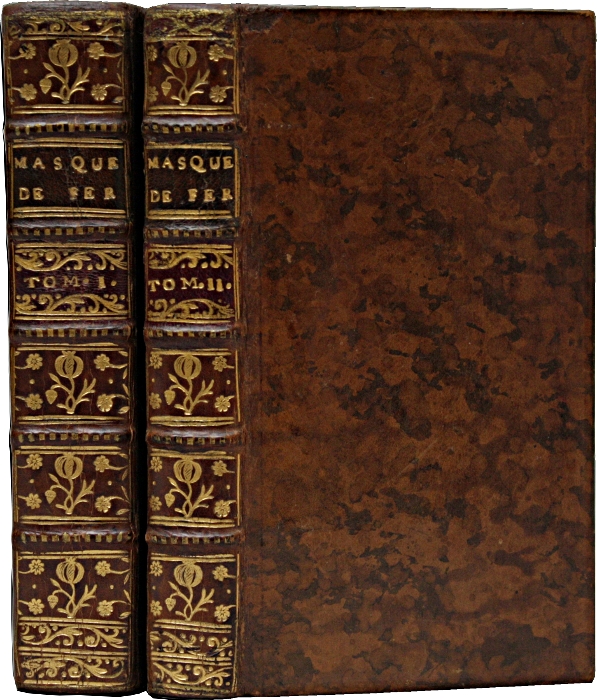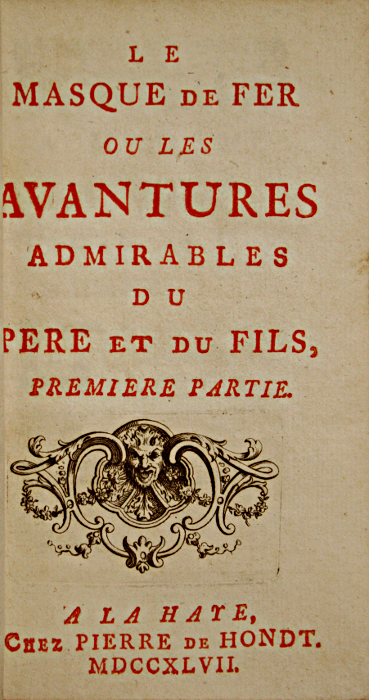MOUHY, Charles de. Le masque de fer ou les Avantures admirables du père et du fils (six parties). The Hague, Piere de Handt, 1747. Followed with : LA DIXMERIE. Livre d’airain. Histoire Indienne. Paris, 1759.
A total of 2 volumes 12mo [139 x 81 mm]. Brown marbled calf, blind-stamped gilt filet on covers, spines ribbed and decorated with gilt fleurons, red edges. Contemporary binding.
First editions of these two historical novels published under the reign of Louis XV.
The first one, dedicated to the countess de Tremes, presents the romanticized episodes of this “so peculiar and so interesting story” of the enigma of the Masque de Fer which excited the minds in the middle of the 18th century.
The first mention that has been made of the prisoner with the iron mask appears in a small anonymous book: « Mémoires secrets pour servir à l’histoire de Perse » (Amsterdam, 1745). This prisoner transferred from the citadel of Ormus (Island Ste Marguerite) to the one of Ispahan (the Bastille) is nobody else but the count de Vermandois, son of Louis XIV and of Miss de la Vallière, incarcerated for slapping in the face the Dauphin and who was passed off as dead because of plague. Voltaire himself tackles this enigma in « Le siècle de Louis XIV » published in 1751.
« Few months after Mazarin’s death, an unknown prisoner, of a height taller than usual, young and with the most beautiful and noble face was sent in the greatest secret to the castle of the Island Ste Marguerite. This prisoner was wearing a mask which chin strap had steel springs that let him the freedom to eat with the mask on his face. The order was to kill him if he took it off. He stayed on the island until a reliable officer, named Saint-Mars, governor of Pignerol, appointed governor of the Bastille in 1690 went to take him in the Island Ste Marguerite and brought him to the Bastille, still masked. The marquis de Louvois went to see him before the transfer and talked to him standing with a consideration that could be considered as respect. This anonymous was taken to the Bastille. He was refused nothing. His greatest taste was for linen of an extraordinary delicacy and for laces. He played the guitar. He was having the biggest chair and the governor rarely sat in front of him. This stranger died in 1703 and was buried at night at the parish of Saint Paul.
Voltaire came back to this question in the seventh edition of his « Dictionnaire encyclopédique », article Ana. He let his editor insert this note that was probably his: “The man with the iron mask was probably an elder brother of Louis XIV. Louis XIII was not living with the queen anymore. The queen might have imagined that it was her fault that no heir was coming for Louis XIII. The birth of the man with the iron mask made her realize her mistake … the queen and the cardinal, both concerned by the necessity to hide from Louis XIII the existence of the man with the iron mask, would have raised him in secret. This secret would have remained until Mazarin’s death.”
Louis XIV judged he couldn’t use a fairer and wiser mean than the one he used to ensure peace and quietness to the state.
This very fine first edition is decorated on each of the six titles printed in red, with different engraved borders.
Bound after, the attractive novel of Bricaire de la Dixmerie, Le Livre d’Airain or Histoire Indienne is preceded with Voltaire’s quote: « que de faibles ressorts font d’illustres destins ».
A very attractive collection of two novels from the 18th century covered with a fine and fresh contemporary binding with particularly decorative spines.



